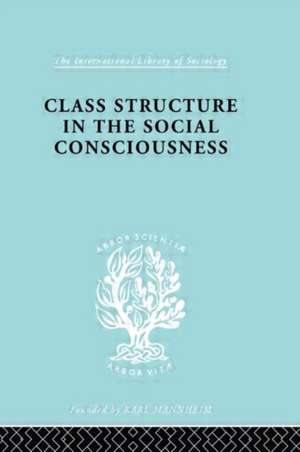Class Structure in the Social Consciousness: International Library of Sociology
Autor Stanislaw Ossowskien Limba Engleză Hardback – 29 ian 1998
| Toate formatele și edițiile | Preț | Express |
|---|---|---|
| Paperback (1) | 239.86 lei 6-8 săpt. | |
| Taylor & Francis – 14 aug 2018 | 239.86 lei 6-8 săpt. | |
| Hardback (1) | 1183.48 lei 6-8 săpt. | |
| Taylor & Francis – 29 ian 1998 | 1183.48 lei 6-8 săpt. |
Din seria International Library of Sociology
-
 Preț: 356.63 lei
Preț: 356.63 lei -
 Preț: 394.62 lei
Preț: 394.62 lei -
 Preț: 358.40 lei
Preț: 358.40 lei - 15%
 Preț: 404.62 lei
Preț: 404.62 lei - 8%
 Preț: 382.16 lei
Preț: 382.16 lei - 33%
 Preț: 488.64 lei
Preț: 488.64 lei - 34%
 Preț: 1182.96 lei
Preț: 1182.96 lei - 34%
 Preț: 1181.31 lei
Preț: 1181.31 lei - 34%
 Preț: 1042.56 lei
Preț: 1042.56 lei - 31%
 Preț: 328.22 lei
Preț: 328.22 lei - 34%
 Preț: 1348.74 lei
Preț: 1348.74 lei - 34%
 Preț: 1045.20 lei
Preț: 1045.20 lei - 34%
 Preț: 1042.56 lei
Preț: 1042.56 lei - 34%
 Preț: 1404.44 lei
Preț: 1404.44 lei - 34%
 Preț: 1042.56 lei
Preț: 1042.56 lei - 34%
 Preț: 1042.98 lei
Preț: 1042.98 lei - 34%
 Preț: 1045.42 lei
Preț: 1045.42 lei - 34%
 Preț: 1182.54 lei
Preț: 1182.54 lei - 34%
 Preț: 1461.29 lei
Preț: 1461.29 lei -
 Preț: 446.53 lei
Preț: 446.53 lei - 34%
 Preț: 1042.68 lei
Preț: 1042.68 lei - 34%
 Preț: 1404.44 lei
Preț: 1404.44 lei - 34%
 Preț: 1962.29 lei
Preț: 1962.29 lei - 34%
 Preț: 1184.18 lei
Preț: 1184.18 lei - 34%
 Preț: 1042.56 lei
Preț: 1042.56 lei - 31%
 Preț: 352.95 lei
Preț: 352.95 lei - 34%
 Preț: 1407.29 lei
Preț: 1407.29 lei - 30%
 Preț: 332.87 lei
Preț: 332.87 lei - 34%
 Preț: 1350.78 lei
Preț: 1350.78 lei - 34%
 Preț: 1208.76 lei
Preț: 1208.76 lei - 34%
 Preț: 1348.74 lei
Preț: 1348.74 lei - 37%
 Preț: 1181.73 lei
Preț: 1181.73 lei - 34%
 Preț: 1182.96 lei
Preț: 1182.96 lei - 18%
 Preț: 1014.47 lei
Preț: 1014.47 lei - 34%
 Preț: 1185.47 lei
Preț: 1185.47 lei - 34%
 Preț: 1348.74 lei
Preț: 1348.74 lei - 30%
 Preț: 335.39 lei
Preț: 335.39 lei - 34%
 Preț: 1041.33 lei
Preț: 1041.33 lei - 29%
 Preț: 339.90 lei
Preț: 339.90 lei - 31%
 Preț: 341.46 lei
Preț: 341.46 lei - 34%
 Preț: 1043.58 lei
Preț: 1043.58 lei - 18%
 Preț: 1066.09 lei
Preț: 1066.09 lei - 34%
 Preț: 1180.11 lei
Preț: 1180.11 lei - 34%
 Preț: 1184.18 lei
Preț: 1184.18 lei - 34%
 Preț: 1683.16 lei
Preț: 1683.16 lei - 34%
 Preț: 1043.37 lei
Preț: 1043.37 lei - 30%
 Preț: 332.44 lei
Preț: 332.44 lei - 30%
 Preț: 358.44 lei
Preț: 358.44 lei
Preț: 1183.48 lei
Preț vechi: 1791.47 lei
-34% Nou
Puncte Express: 1775
Preț estimativ în valută:
226.46€ • 233.63$ • 188.98£
226.46€ • 233.63$ • 188.98£
Carte tipărită la comandă
Livrare economică 26 martie-09 aprilie
Preluare comenzi: 021 569.72.76
Specificații
ISBN-13: 9780415176187
ISBN-10: 0415176182
Pagini: 210
Dimensiuni: 138 x 216 x 21 mm
Greutate: 0.55 kg
Ediția:1
Editura: Taylor & Francis
Colecția Routledge
Seria International Library of Sociology
Locul publicării:Oxford, United Kingdom
ISBN-10: 0415176182
Pagini: 210
Dimensiuni: 138 x 216 x 21 mm
Greutate: 0.55 kg
Ediția:1
Editura: Taylor & Francis
Colecția Routledge
Seria International Library of Sociology
Locul publicării:Oxford, United Kingdom
Cuprins
Chapter 1 Introduction; Part I From Biblical Legends to Contemporary Sociology; Chapter 2 Dichotomic Conceptions of Class Structure – One Group Set Over Another; Chapter 3 The Scheme of Gradation1The term ‘gradation’ (Polish gradacja) is retained in the translation, instead of using the more familiar ‘ranking’, because the author clearly differentiates between them. ‘Rank’, as used in American and English sociology, refers to the relative position or status of members of a group with respect to each other as assigned and evaluated by themselves or by the researcher. Therefore, a sequence of degrees in rank is either something subjectively perceived or intuitively assessed. But not every sequence of degrees in rank is based on a subjective evaluation. When individuals are ranked according to their education or wealth, an objectively valid criterion of rank is applied. ‘Gradation’ denotes both the subjectively evaluated and the objectively measured rank and differentiates them by qualifying the latter as ‘simple’ and the former as ‘synthetic gradation’ (note by Dr. Z. Jordan).; Chapter 4 Functional Conceptions; Chapter 5 The Marxian Synthesis; Chapter 6 The Class-Hierarchy and the Social-Status Continuum; Chapter 7 Non-Egalitarian Classlessness–Similarities in Interpreting Mutually Opposed Systems; Part II Conceptual Constructs and Social Reality; Chapter 8 The Three-Fold Denotation Of The Term ‘Social Class’; Chapter 9 The Concept of Social Class; Chapter 10 Types of Interpretation of the Social Structure – an Attempt at Classification; Chapter 11 Semantic Conventions Considered as Social Facts; Chapter 12 Interpretations of Class Structure in Historical Perspective;
Notă biografică
Stanislaw Ossowski, Sheila Patterson
















